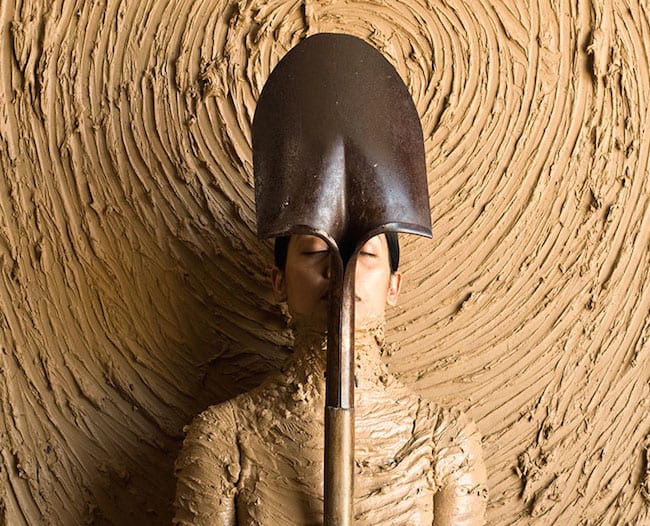“The Hindu does not worship an idol.
Made of wood and clay.
He sees consciousness
Within the earthen-ness
And loses himself in it.”
— Swami Vivekananda

Anindita Dutta, From Maya, 2014. Arthur M. Sackler Museum of Art at Peking University, Beijing.
India-born and USA-based Anindita Dutta works on performances and sculptural installations, mainly in the medium of unfired clay which explore inner struggles taking place within the within the chaos of life, dialogues on how psychological, social and political conflicts shape our desires and mortal existence.
The uniqueness of Anindita’s performances is the synthesis of medium and the concept. Through extensive use of clay she has acquired her own medium of expression. Anindita transfers her energy and thought into a direct medium and leaves her presence, marks and movement in the clay, which she captures in video and photo documentation.


From “Life LIne” by Anindita Dutta.
Anindita’s work has been exhibited widely in the USA, France, India, Brazil, Chille and Germany, including the Queens Museum of Art in NYC and Fukuoka Asian Art Museum in Japan. She has been awarded grants from Fukuoka Asian Art Museum (Japan 2010), The Pollock-Krasner Foundation (2008), Art Omi International Art Center (New York 2006), UNESCO-Aschberg Bursaries Fellowship (2006), KHOJ Kolkata International Workshop (India 2006) CAMAC, Marnay-sur-seine (France 2005).

Anindita Dutta, Loss of Identity, 2003, burlap, cotton, wet clay, 192 x 72 inches. Courtesy of the artist.
Academically trained as a sculptor and coming from the small town of Purnia in the north of India, close to the border of Nepal, clay or soil was a part of her living environment and the material was a natural choice for the artist to work with:
” Clay is a direct medium. I can express my feelings right away without having to wait for the post-processing of the material. I can transfer my energy, deep thoughts easily through textures on clay. It is a medium close to my heart. I am a tactile person. If I am interested in something, I cannot help touching it, feeling it. You will be surprised to know how malleable clay is. Besides, clay is universal. It comes from our mother earth, everyone in their childhood memory has at least once played with clay. You can find clay anywhere in the world, in any region, but each lump of clay speaks so much about itself.”


Anindita Dutta, from “Everything Ends and Everything Matters,” 2014. Presented by Latitude 28 at India Art Fair, 2014.
Also sculpting or even performing with raw plastic clay has been a tradition in India for millennia. In the Hindu religion deities could only be represented in unfired, “apakva” (terracruda), and not fired clay (terracotta) because after firing the clay was gone and dead. With unfired friable clay, water returns the clay to the soil and so the medium, earth mother, is undamaged and lives on. India is one of the few countries where the tradition of extraordinary complex terracruda sculpture, made for the festival season, mainly in a religious context for worship, continues and is still widespread.

Anindita Dutta, from “Wrest in Peace,” 2010, video. Performed by students from Kyushu Sangyo University’s Fine Arts Department. Courtesy of the artist.
In an article in art international about two of the installations featured in this post Kanae Hasegawa writes:
“As Anindita mentions, indeed, the color, the texture, the density of the sand, clay can show extensive diversity even taken from just one island. In Japan, in one of small islands in the Pacific sea, you can have about 600 different color tones in clay.
“Individually as the clay exists, at the same time, clay can homogenise uniformly for different objects. Once you cover the human body with clay, it is as if this human life disappears and the human substance becomes like a statuette. That is why the audiences who happened to pass by the performance were awe-struck since they thought these amateur performers were lifeless and not really human…

Anindita Dutta, from “A Mazing,” 2010, video. Performed by students from Kyushu Sangyo University’s Fine Arts Department. Courtesy of the artist.
“…The border between living and non-living material is an issue Anindita has been exploring throughout her work. It is a natural thought that once you are covered with clay you will lose your identity as everything will be absorbed by the clay and you will be disappearing from public view. But it is probably due to her Indian philosophy about the human body and life after death. ‘Life is an accumulation of non-living materials. But eventually, living things do become non-living,’ she says.”

Anindita Dutta, Limitation I, 2004, photo documentation from performance, France. Courtesy of the artist.
For this remarkable artist clay is the perfect medium in which to express these feelings. “It is a fundamentally a building block of earth yet fragile in itself. We interact with it every day without realizing the actual importance. By presenting clay overwhelmingly in my work I want to force the viewers to rethink about clay and its closeness to our valued life.”
Garth Clark is the Chief Editor of CFile.

Anindita Dutta, Limitation II, 2005, photo documentation from performance, USA. Courtesy of the artist.

Anindita Dutta

I am thinking there must also be a tremendous feeling of dampness and that familiar smell of wet clay in the air, also adding to the viewing and making process
. . . rich in texture, form, space, and meaning . . .